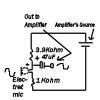bluethecow
New Member
I'm extremely new to building circuits etc, as I come from the high-level software world, so please don't flame me  .
.
I have a microphone and a speaker with plugs that connect to my computer's PCI sound card, and I want to build a small circuit to connect the two, separate of a PC, so that when sound goes into the microphone, it comes out from the speaker. I've read a bit about microphones and speakers and how they work, but I couldn't find much more information than that when searching, mostly because I'm not sure exactly what to search for. Can someone point me in the right direction?
I have a microphone and a speaker with plugs that connect to my computer's PCI sound card, and I want to build a small circuit to connect the two, separate of a PC, so that when sound goes into the microphone, it comes out from the speaker. I've read a bit about microphones and speakers and how they work, but I couldn't find much more information than that when searching, mostly because I'm not sure exactly what to search for. Can someone point me in the right direction?


